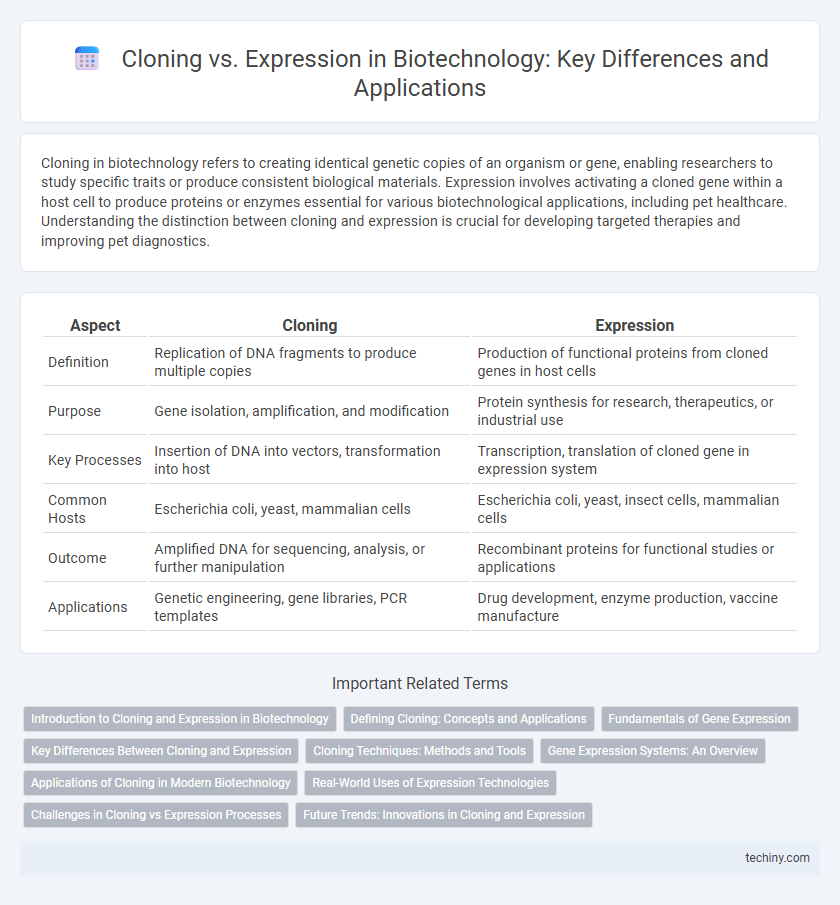Cloning in biotechnology refers to creating identical genetic copies of an organism or gene, enabling researchers to study specific traits or produce consistent biological materials. Expression involves activating a cloned gene within a host cell to produce proteins or enzymes essential for various biotechnological applications, including pet healthcare. Understanding the distinction between cloning and expression is crucial for developing targeted therapies and improving pet diagnostics.
Table of Comparison
| Aspect | Cloning | Expression |
|---|---|---|
| Definition | Replication of DNA fragments to produce multiple copies | Production of functional proteins from cloned genes in host cells |
| Purpose | Gene isolation, amplification, and modification | Protein synthesis for research, therapeutics, or industrial use |
| Key Processes | Insertion of DNA into vectors, transformation into host | Transcription, translation of cloned gene in expression system |
| Common Hosts | Escherichia coli, yeast, mammalian cells | Escherichia coli, yeast, insect cells, mammalian cells |
| Outcome | Amplified DNA for sequencing, analysis, or further manipulation | Recombinant proteins for functional studies or applications |
| Applications | Genetic engineering, gene libraries, PCR templates | Drug development, enzyme production, vaccine manufacture |
Introduction to Cloning and Expression in Biotechnology
Cloning in biotechnology involves creating identical copies of a DNA sequence, gene, or organism to study genetic functions or produce specific proteins. Expression refers to the process where cloned genes are activated within host cells to synthesize their corresponding proteins. Understanding the mechanisms of both cloning and expression is essential for advancements in genetic engineering, pharmaceutical development, and synthetic biology.
Defining Cloning: Concepts and Applications
Cloning in biotechnology refers to the process of creating identical copies of a specific DNA fragment, gene, or organism, enabling detailed genetic analysis and manipulation. It involves the insertion of a target DNA sequence into a vector, followed by propagation in a host cell, which is essential for gene characterization, protein production, and genetic modification. Key applications of cloning include the development of genetically engineered organisms, production of recombinant proteins, and advancement of gene therapy techniques.
Fundamentals of Gene Expression
Gene expression is the process by which genetic information from DNA is transcribed into RNA and translated into proteins, essential for cellular function and phenotype manifestation. Cloning involves creating identical copies of DNA sequences, enabling the isolation and amplification of specific genes for further study or protein production. Understanding the fundamentals of gene expression allows for precise manipulation in cloning experiments to achieve desired protein expression levels in biotechnology applications.
Key Differences Between Cloning and Expression
Cloning involves creating multiple copies of a specific DNA fragment or gene, often by inserting it into a vector for replication within a host organism, while expression refers to the process of producing the functional protein encoded by that gene. Cloning focuses on gene replication and amplification, whereas expression emphasizes transcription and translation of the cloned gene into a protein product. Key differences lie in the objectives, with cloning aimed at gene duplication and expression targeting protein synthesis within a biological system.
Cloning Techniques: Methods and Tools
Cloning techniques in biotechnology primarily involve the insertion of DNA fragments into vectors such as plasmids, cosmids, or bacteriophages to replicate specific gene sequences. Common methods include restriction enzyme digestion, ligation, and transformation, with tools like CRISPR-Cas9 enabling precise gene editing. These techniques facilitate the amplification, modification, and analysis of genetic material critical for gene expression studies and recombinant protein production.
Gene Expression Systems: An Overview
Gene expression systems are fundamental tools in biotechnology for producing recombinant proteins by introducing cloned genes into host organisms such as bacteria, yeast, or mammalian cells. Cloning involves isolating and replicating a specific gene, while expression focuses on the transcription and translation of that gene to synthesize functional proteins. Optimizing factors like promoter selection, vector design, and host compatibility enhances protein yield, making gene expression systems crucial for research, pharmaceutical development, and industrial applications.
Applications of Cloning in Modern Biotechnology
Cloning in modern biotechnology enables the replication of specific genes or entire organisms, facilitating advances in genetic research, drug development, and agriculture. Applications include producing genetically identical plants with desirable traits, creating animal models for disease study, and manufacturing recombinant proteins for therapeutic use. Cloning also supports gene editing techniques by providing consistent genetic material for precise modifications.
Real-World Uses of Expression Technologies
Expression technologies enable the production of therapeutic proteins, vaccines, and enzymes by introducing genes into host cells such as bacteria, yeast, or mammalian cells. This approach supports large-scale manufacturing of insulin, monoclonal antibodies, and recombinant hormones, crucial for treating diseases like diabetes, cancer, and autoimmune disorders. Cloning primarily serves as a tool to generate DNA constructs for expression but does not directly produce functional proteins for commercial or clinical use.
Challenges in Cloning vs Expression Processes
Challenges in cloning arise from difficulties in inserting large or complex DNA sequences into vectors, often facing issues with vector compatibility and low transformation efficiency. Expression processes encounter obstacles such as improper protein folding, inclusion body formation, and insufficient post-translational modifications, which affect protein yield and functionality. Both cloning and expression require optimized host systems and precise control of conditions to overcome these biological and technical limitations.
Future Trends: Innovations in Cloning and Expression
Advancements in synthetic biology are driving innovations in cloning techniques, enabling more precise gene editing and enhanced expression systems for therapeutic protein production. CRISPR-based methods continue to revolutionize cloning by increasing efficiency and reducing off-target effects, promising accelerated development of genetically engineered organisms. Enhanced expression platforms, including cell-free and modular systems, are optimizing protein yield and functional diversity, paving the way for scalable biopharmaceutical manufacturing.
Cloning vs Expression Infographic

 techiny.com
techiny.com